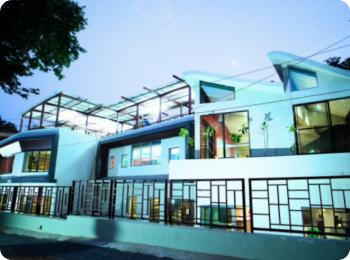The pace of global warming is increasing at an alarming rate with India emerging as the fourth-largest contributor of carbon emissions worldwide. Greenhouse gases play a significant role in environmental pollution and the construction sector is held accountable for approximately 19% of it. India has set a net zero target for the first time, aiming to reduce its emissions by 2070.
Why is there a need to focus on buildings and the construction sector?
The condition of the environment is deteriorating progressively owing to the presence of hazardous air pollutants, predominantly black carbon. India holds the position of the world’s fourth highest carbon emitter and the rate of global warming is rapidly accelerating. Greenhouse gases are the primary contaminants present in the environment, and the construction sector is believed to contribute to 19% of their emissions. Infrastructure is an essential requirement for the survival of developing countries like India. Without it, the country’s existence is jeopardized. Construction and buildings contribute significantly to the carbon footprint, accounting for around 40% of it. This high percentage can be attributed to several factors such as the use of electricity for lighting, cooling and heating building materials. As per the Paris Agreement outlined in a paper by World Resources Institute, it is projected that buildings will strive for net-zero carbon emissions by 2050. Currently, buildings that can contribute towards reaching the goal of zero are very few, and Bootes seeks to change that equation as the first Net-Zero company in India.
The concern remains regarding the means by which the objective can be accomplished, as the construction industry plays a pivotal role in the development of any country and cannot be halted. This can be achieved by creating a building with a low energy consumption design and replacing traditional fossil fuels used in construction with renewable, carbon-free energy sources.
How can buildings help achieve net-zero?
In every building endeavor, there exist two categories of carbon dioxide discharges, namely direct and indirect. The detrimental impact on the environment is equivalent for both. Activities like the extraction of natural resources, setting up of manufacturing facilities, and the dismantling of structures contribute to the deterioration of the climate. The problem of a rising carbon footprint is not limited to a single nation. It is a universal concern that led to a conference in Glasgow where India showcased its “panchamrit,” a strategy to accomplish five key climate objectives. One of the goals is to reach a state of complete absence of emissions by the year 2070. India’s goal is to rely on renewable energy sources for half of its energy needs by 2030. By 2030, it is expected that there will be a decrease of 1 billion tons in the total amount of carbon emissions. This will be achieved by reducing carbon intensity by 45% from 2005 levels and attaining a non-fossil energy capacity of 500GW.
The focus of the building sector should be on promoting recycling as a means to both prolong the life of materials and lessen the amount of waste. A few strategies for this is to procures large quantities of materials and employs them to generate transport solutions, ultimately resulting in a decrease in the emission of carbon in the environment. Reduction of wastage must also be seen from an upstream and downstream energy perspective. Using energy efficient and electric technologies results in demanding less energy from the fossil-fuel run grid, thus reducing wastages. Reusing can be accounted for in eco-friendly building materials and reusing the energy within the building using hydronic systems to balance the energy needs. Measures of efficiency also include designing buildings that incorporate elements such as daylighting, extra insulation, LED lighting, and energy-efficient equipment.
Undeniably, the allocation of USD 237 billion towards energy-efficient building materials has observed a significant 16% surge in 2021. However, recent findings suggest that the reduction of CO2 emissions remains elusive. By focusing on the three pillars of reduce, reuse, and recover, the construction industry must develops solutions that prioritize energy efficiency. Companies must invest in initiatives aimed at reducing greenhouse gases and offering carbon offset options to clients, which include the establishment of wind farms, tree plantations, geothermal power plants, projects for clean drinking water, and solar power projects. We must all striving to minimize carbon footprint through all possible means and be determined to assist the country in meeting its targets. Our future can only be brighter if we start taking the necessary actions.
More About Bootes: India’s first Net-Zero Company
Bootes is at the forefront of the construction industry’s shift towards sustainable and green building practices, and in line with India’s long-term vision. Our strength has been our ability to undertake design, engineering and construction for our projects to incorporate a net zero implementation plan from the very beginning to achieve sustainable / aatmanirbhar infrastructure.
Our commitment to sustainability is reflected in our use of cutting-edge technology and innovative construction models, which are environmentally friendly and energy-efficient. Some of the key methodology that we incorporate are:
- We implement energy efficiency measures in the buildings, to reduce energy consumption and costs.
- We use world-class technology such as hydronic systems, efficient energy storage, high temperature cooling & low temperature heating, carbon capture, to achieve carbon neutral / positive buildings.
- We Integrate renewable energy sources, such as solar, wind power, biofuels to reduce reliance on fossil fuels in our infrastructures.
- We integrate Zero liquid discharge & Zero waste systems for water conservation and waste management.
- We use sustainable materials and construction practices inspired from ancient Indian architecture.
- We collaborate with stakeholders, including governments, businesses, and communities, to ensure buy-in and support for net zero infrastructure initiatives.
With Net-Zero infrastructure, we not only deliver reduced carbon footprint, but also reduced operating costs.







